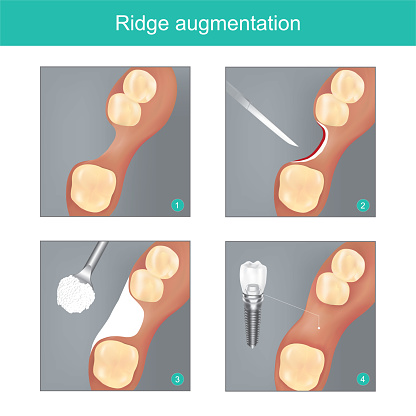Ridge Augmentation Stratford CT Sometimes tooth removal is inevitable. Whether you lose a tooth because of an accident or an injury, or if you lose it due to tooth decay or gum disease, losing a tooth can cause trouble. Sometimes, we have no choice but to remove a diseased tooth from your jaw, because by removing a tooth, we can save other teeth. While we must remove teeth to save other teeth, we don’t like to leave empty sockets where teeth used to be. Over time, those empty sockets can result in bone loss - which can damage your jaw. Sometimes tooth removal is inevitable. Whether you lose a tooth because of an accident or an injury, or if you lose it due to tooth decay or gum disease, losing a tooth can cause trouble. Sometimes, we have no choice but to remove a diseased tooth from your jaw, because by removing a tooth, we can save other teeth. While we must remove teeth to save other teeth, we don’t like to leave empty sockets where teeth used to be. Over time, those empty sockets can result in bone loss - which can damage your jaw. Bone loss can actually change your jawline or even your facial structure. Rather than leave you with empty sockets, we can restore your jaw and replace teeth that have been lost. We have several practices we can use to make improvements to your teeth and jaw. One of the procedures we use most often is ridge augmentation. How does ridge augmentation work, and how can it improve the look of your jaw? Brush & Floss Dental Center has some facts for you about ridge augmentation. What Is Ridge Augmentation?Ridge augmentation was invented by people in the industry after intensive studying of patients with tooth and bone loss. When we have to extract a tooth, we want to replace the empty socket with an implant as soon as possible. There are times, however, when we aren’t able to immediately replace your missing tooth. In a mouth that has not been affected by tooth loss, the roots of the tooth are surrounded by a structure called the alveolar ridge. The ridge is actually a piece of bone that surrounds the teeth and helps to anchor the teeth into the jawbone. If you are young when you lose one of your permanent teeth, the empty socket will fill up with bone and tissue, which makes the gumline look even. If you lose teeth at an older age, this “filling in” process is less likely. There are times when the mouth cannot replace the bone and tissue that is missing, because of tooth decay or gum disease. Traumatic accidents and injuries can also cause problems with your jaw. In those cases, a traditional dental implant can’t work. We have to do a procedure first to rebuild the ridge, or sometimes change the width of the alveolar ridge. Once we have rebuilt the ridge, we can then give you implants. How Is Ridge Augmentation Done?If possible, we would want to begin replacing the alveolar ridge by placing a bone graft in the empty tooth socket. We place gum tissue over the graft and stitch up the area. However, sometimes we will need to do more work. We may have to do a ridge expansion, if the jawbone is not high or wide enough for an implant to work. When we expand the ridge, we work to build your bone up. We make holes in the jawbone and add material to build up your jaw. We then give the area time to heal before we place the implant. Usually, the healing time for ridge augmentation takes between three months and six months. Do you have questions about ridge augmentation? We have answers. Give Brush & Floss Dental Center a call at (203) 378-9500. |
|
|